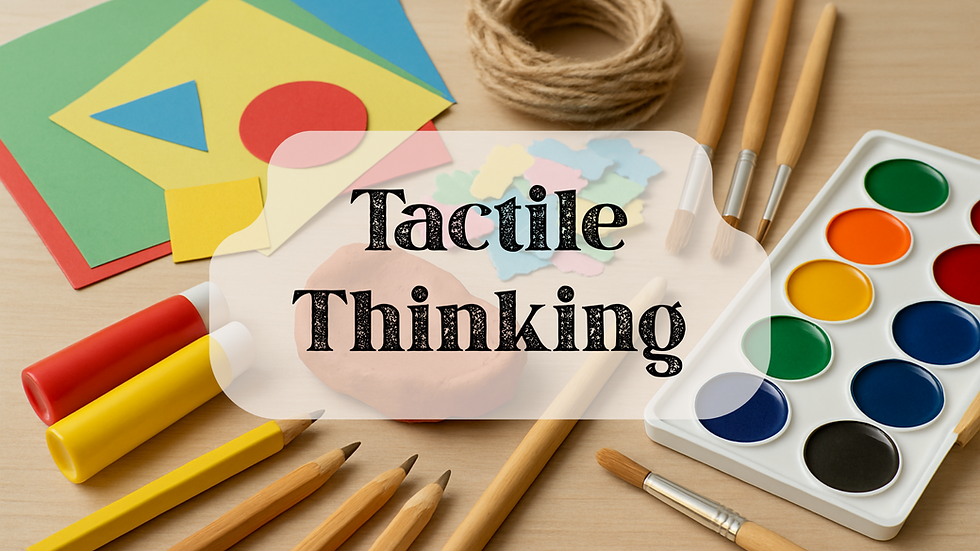Why Crafting is Good for Mental Health
- Brandy Prettyman
- Aug 14, 2024
- 3 min read
In today’s fast-paced world, finding ways to relax and take care of our mental well-being has never been more important. While many people turn to exercise, meditation, or social activities to unwind, there’s another powerful tool that often goes overlooked: arts and crafts. Engaging in creative activities not only offers a sense of accomplishment but also provides significant benefits for mental health. In this post, we’ll explore how crafting can reduce stress, enhance creativity, and improve overall mental well-being.

1. Reducing Stress through Crafting
Stress is a common part of daily life, whether it’s caused by work, personal responsibilities, or unexpected challenges. Over time, chronic stress can take a toll on both the body and mind, leading to burnout and other health issues. That’s where arts and crafts come in.
When you immerse yourself in a creative activity, your mind shifts focus away from stressors and towards the task at hand. Whether you’re knitting, painting, or sculpting, the repetitive motions and concentration required in these activities can create a calming effect, similar to meditation. This “flow state” allows you to temporarily escape from your worries and experience a sense of peace and relaxation.
Crafting also provides a tangible way to process emotions. For example, working with your hands—cutting paper, molding clay, or stitching fabric—can be a physical outlet for releasing pent-up tension and frustration. The satisfaction of creating something with your own hands offers a sense of control and accomplishment, which can be particularly empowering during stressful times.
2. Enhancing Creativity
Creativity isn’t just for artists—it’s a vital skill that can benefit everyone in different aspects of life. Whether you’re solving a problem at work, coming up with new ideas, or simply looking for a fresh perspective, creativity plays a key role. Engaging in arts and crafts is one of the most effective ways to nurture and enhance this skill.
When you experiment with different materials, colors, and techniques, you’re pushing the boundaries of your imagination. Crafting encourages you to think outside the box and explore new ways of expressing yourself. Over time, these creative exercises can help you develop a more flexible and innovative mindset, which can be applied to other areas of your life.
Moreover, the creative process often involves trial and error. Not every project will turn out as planned, but that’s part of the beauty of crafting. These small “failures” teach you to embrace mistakes as learning opportunities and to approach challenges with resilience and an open mind. This attitude of curiosity and experimentation is essential for fostering creativity and personal growth.
3. Improving Mental Well-Being
Crafting can have profound effects on your overall mental well-being. In addition to reducing stress and enhancing creativity, it can also help with managing anxiety and depression, boosting self-esteem, and promoting mindfulness.
- Managing Anxiety and Depression: Creative activities can provide a welcome distraction from negative thoughts and feelings, offering a safe space to express emotions that might be difficult to articulate otherwise. The sense of purpose and achievement that comes from completing a project can also lift your mood and improve your outlook.
- Boosting Self-Esteem: When you create something with your own hands, you gain a sense of pride and confidence in your abilities. This boost in self-esteem can translate into other areas of your life, helping you to tackle new challenges with greater assurance.
- Promoting Mindfulness: Crafting encourages you to focus on the present moment, which is a core aspect of mindfulness. By paying attention to the details of your work—whether it’s the texture of the yarn, the brushstrokes of paint, or the intricacies of a design—you’re practicing mindfulness, which has been shown to reduce symptoms of anxiety and depression.
Getting Started with Crafting
If you’re new to crafting, don’t worry—you don’t need to be an expert to enjoy the benefits. The key is to find a creative activity that you enjoy and that allows you to unwind. Here are a few ideas to get you started:
- Knitting or Crocheting 🧶: These repetitive, rhythmic activities are known for their calming effects and are great for beginners.
- Painting or Drawing 🎨: Even if you don’t consider yourself an artist, playing with colors and shapes can be incredibly therapeutic.
- Paper Crafts 💮: Origami, scrapbooking, and card-making are fun ways to create something beautiful while focusing your mind.
- Pottery or Clay Sculpting 🏺: Working with clay is a tactile experience that can be both grounding and expressive.
Incorporating arts and crafts into your routine is more than just a creative pastime—it’s a powerful tool for enhancing your mental well-being. By reducing stress, fostering creativity, and improving your overall mental health, crafting can become a vital part of your self-care routine. So why not give it a try? You might just discover that your next favorite hobby is also your best ally in achieving a balanced, healthy mind.




Comments